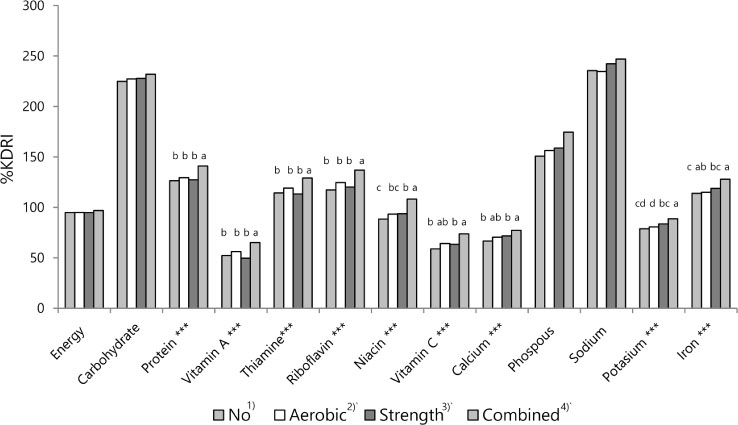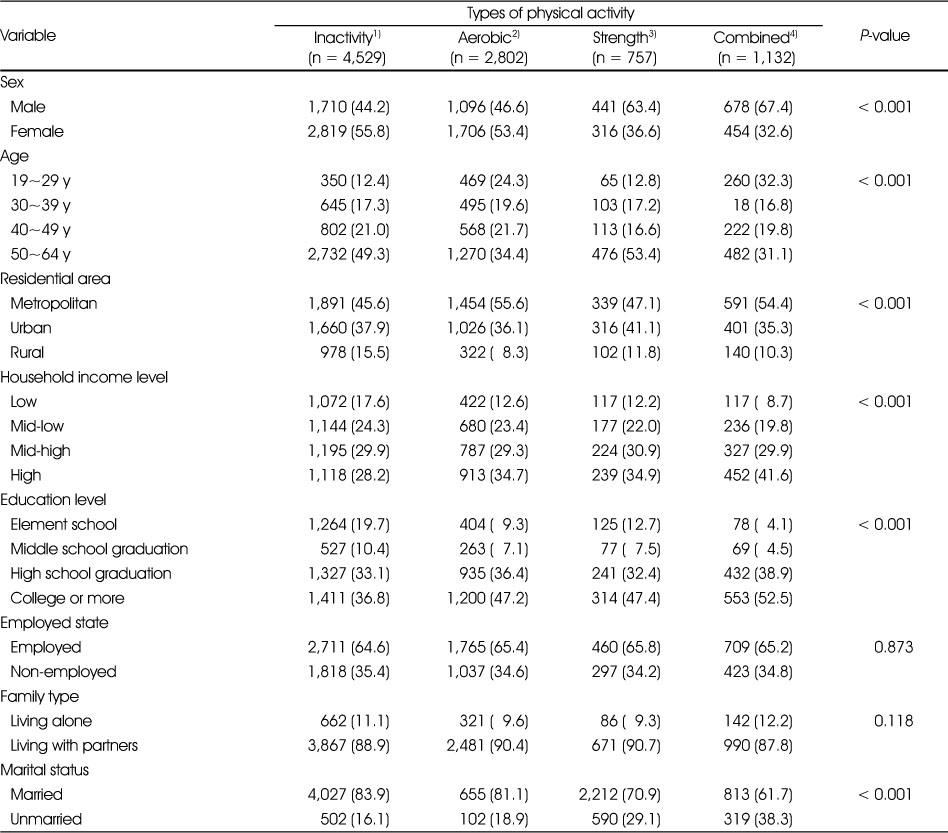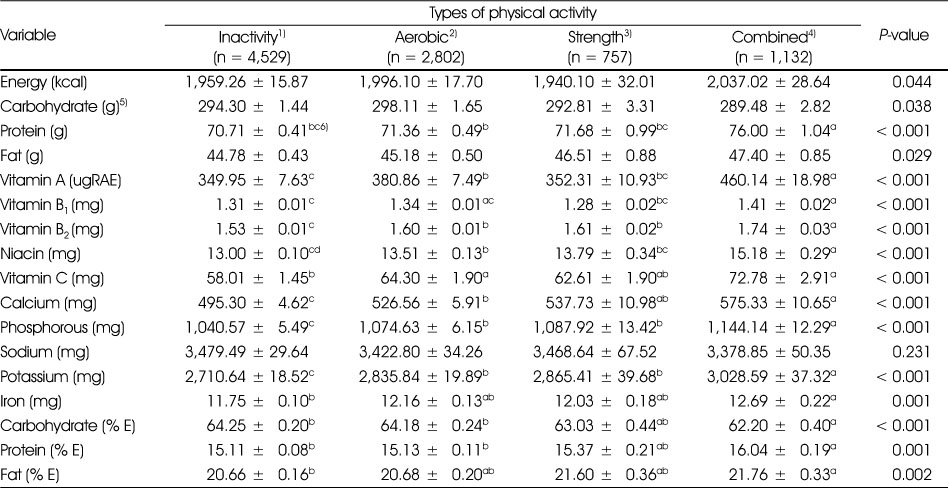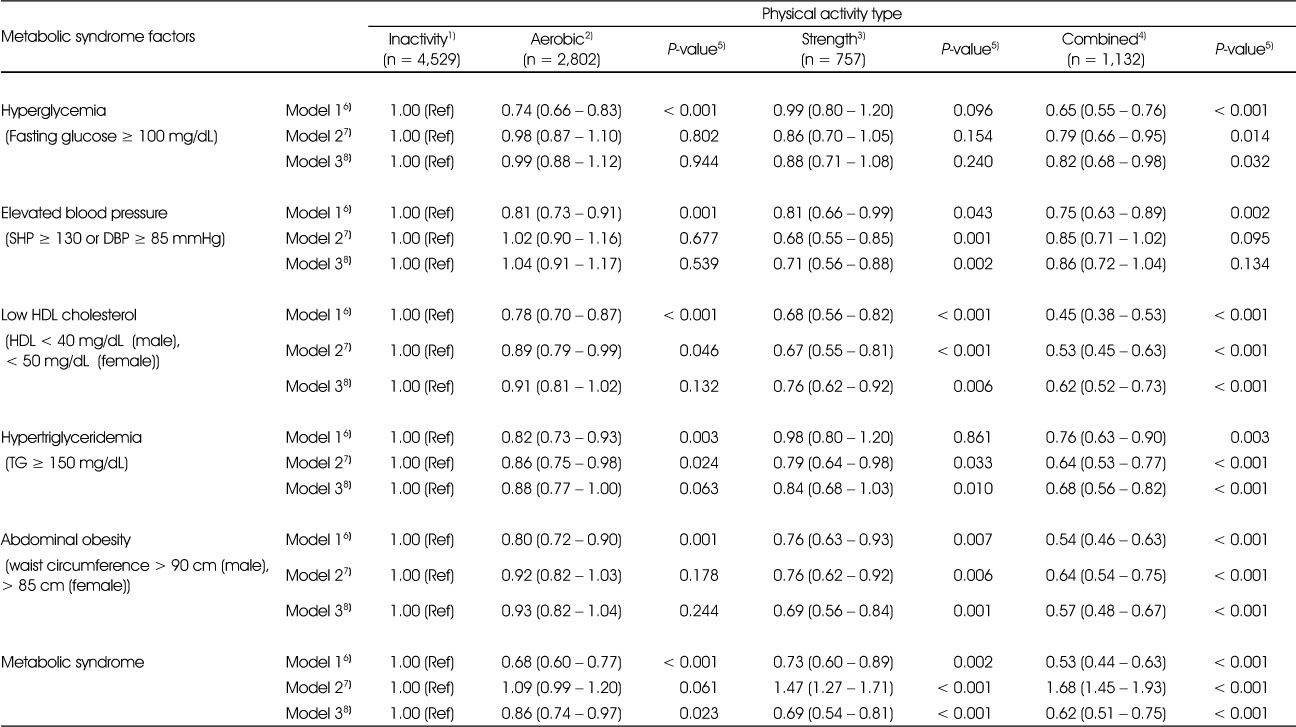Articles
- Page Path
- HOME > Korean J Community Nutr > Volume 26(2); 2021 > Article
- Research Article
- The Study of Dietary Habits and Health Behaviors according to Physical Activity Type in Korean Adults -Based on the 2016~2018 Korea National Health and Nutrition Examination Survey-
- Jin-A Kim, Sim-Yeol Lee
-
Korean Journal of Community Nutrition 2021;26(2):122-133.
DOI: https://doi.org/10.5720/kjcn.2021.26.2.122
Published online: April 30, 2021

2Professor, Department of Home Economics Education, Dongguk University, Seoul, Korea

-
Corresponding author:
Sim-Yeol Lee, Tel: +82-2-2260-3413, Fax: +82-2-2265-1170,
Email: slee@dongguk.edu
- 1,287 Views
- 12 Download
- 5 Crossref
- 0 Scopus
Abstract
Objectives
This study evaluated the dietary habits and health behaviors of Korean adults according to their physical activity.
Methods: Adults aged 19~64 years, who participated in the 2016~2018 National Health and Nutrition Examination Survey, were enrolled in this study. The subjects were classified into the physical inactivity group, aerobic physical activity group, strength exercise group, and combined exercise group.
Results: Significant differences in skipping breakfast, frequency of eating out, dietary supplements, and alcohol drinking status were observed among physical activity groups (P < 0.001). The combined exercise group had the highest % KDRI of protein, vitamin A, thiamin, riboflavin, niacin, calcium, potassium, and iron (P < 0.001). The physical inactivity group had the highest obesity rate (35.1%), and they perceived their body image type to be obese. In the combined exercise group, 47.8% of respondents said they were in good health (P < 0.001). The health-related quality of life score of the physical inactivity group was the lowest, with a score of 0.94. The metabolic syndrome risk rate of the combined exercise group was lower at 0.62 times (95% CI, 0.51-0.75) than the physical inactivity group.
Conclusions: The physical activity type was associated with metabolic syndrome.
These results can be useful for supporting dietary education and physical activity programs for adults.
Published online Apr 30, 2021.
https://doi.org/10.5720/kjcn.2021.26.2.122
The Study of Dietary Habits and Health Behaviors according to Physical Activity Type in Korean Adults: Based on the 2016~2018 Korea National Health and Nutrition Examination Survey
Abstract
Objectives
This study evaluated the dietary habits and health behaviors of Korean adults according to their physical activity.
Methods
Adults aged 19~64 years, who participated in the 2016~2018 National Health and Nutrition Examination Survey, were enrolled in this study. The subjects were classified into the physical inactivity group, aerobic physical activity group, strength exercise group, and combined exercise group.
Results
Significant differences in skipping breakfast, frequency of eating out, dietary supplements, and alcohol drinking status were observed among physical activity groups (P < 0.001). The combined exercise group had the highest % KDRI of protein, vitamin A, thiamin, riboflavin, niacin, calcium, potassium, and iron (P < 0.001). The physical inactivity group had the highest obesity rate (35.1%), and they perceived their body image type to be obese. In the combined exercise group, 47.8% of respondents said they were in good health (P < 0.001). The health-related quality of life score of the physical inactivity group was the lowest, with a score of 0.94. The metabolic syndrome risk rate of the combined exercise group was lower at 0.62 times (95% CI, 0.51–0.75) than the physical inactivity group.
Conclusions
The physical activity type was associated with metabolic syndrome. These results can be useful for supporting dietary education and physical activity programs for adults.
Fig. 1
% KDRI of nutrient intake according to physical activity type (*** P < 0.001, P-values are from ANOVA test). All the estimates were produced to represent the Korean population using sample weight for the analysis of health and nutrition survey and SAS SURVEY procedure was used to account for multistage sampling and unequally weighted design. 1) A person who do not act physical activity 2) A person who act aerobic physical activity of moderate intensity physical activity at least 150 minutes a week 3) A person who act strength exercise at least 2 times a week 4) A person who act aerobic physical activity and strength exercise
Table 1
General characteristics of the subjects according to physical activity type
Table 2
Dietary habit of the subjects according to physical activity type
Table 3
Nutrients intake of the subjects according to physical activity type
Table 4
Health behavior of the subjects according to physical activity type
Table 5
Weight status, perception, and practices of the subjects according to physical activity type
Table 6
Association of physical activity type with factors of metabolic syndrome
References
-
World Health Organization. More active people for a healthier world. Geneva: World Health Organization; 2018. pp. 14-19.
-
-
World Health Organization. Global recommendations on physical activity for health. Geneva: World Health Organization; 2010. pp. 9-12.
-
-
Ministry of Health and Welfare. The physical activity guide for Koreans. Sejong: Ministry of Health and Welfare; 2013. pp. 7.
-
-
Korea Disease Control and Prevention Agency. The eighth Korea National Health and Nutrition Examination Survey (KNHANES VIII-1), 2019. Cheongju: Korea Disease Control and Prevention Agency; 2020. pp. 126.
-
-
Song YJ, Kwon DK, Bae SH, Seo HS, Lee JB. Effect of regular combined exercise on metabolic syndrome regulating factors in middle aged women. Korea J Sports Sci 2017;26(4):895–904.
-
-
Lee HB. Impact of physical activity level and types of activities of middle-aged women on risk factors of metabolic syndrome and energy metabolism. Korean J Growth Dev 2014;22(4):371–380.
-
-
Kang IW. The analysis of body composition, life style, nutritional status of middle aged men by physical activity level. J Korean Socr Wellness 2017;12(2):359–369.
-
-
Jeon YK, Cho WJ. The comparative analysis of body shape perception, nutritional status and metabolic syndrome factors of middle-aged women by physical activity level. Korean J Phys Educ 2016;55(4):527–539.
-
-
Lee SB, Choi JL. Differences in indicators related to metabolic syndrome according to the physical activity level of adult males in their 30s to 60s: 7th 3rd(2018) Korea National Health and Nutrition Examination Survey. J Korean Soc Wellness 2020;15(2):1–8.
-
-
Son CW, Yang DS. Difference in risk factors for metabolic syndrome according to the condition and type of physical activity in middle age: Data from the Korea National Health and Nutrition Examination Survey (2014-2017). Korea J Sports Sci 2019;28(4):967–984.
-
-
Heo JH. Association between physical activity and perceived stress among Korean adults: A cross-sectional study using 2017 the Korea National Health and Nutrition Examination Survey data. Korean J Stress Res 2019;27(4):313–319.
-
-
Park SY. Associations with physical activity, chronic disease, depression, and health-related quality of life. Korean J Sports Sci 2014;25(2):249–258.
-
-
Park SY, Yun DH. Associations between physical activity and health-related quality of life in Korean adults: KNHANES V-2. Korean J Phys Educ 2014;53(2):201–214.
-
-
Back HH, Jung M. Effects of physical activity in the elderly with osteoarthritis on stress and health-related quality of life (EQ-5D): Using data from the 2018 National Health and Nutrition Survey. J Korea Entertain Ind Assoc 2020;14(5):267–276.
-
-
Lee HM, Jung IK. Relationship among obesity and metabolically health status, physical activities, and nutrient intakes in menopausal women. J Korean Assoc Phys Educ Sport Girls Women 2018;32(2):131–152.
-
-
Yoon BK, Park CH. The changes of health-related fitness for the elderly women depend on the types of exercise. J Korean Appl Sci Technol 2020;37(6):1728–1737.
-
-
Hong JY, Cho JH. Effects of exercise types on appendicular skeletal muscle mass index and anabolic hormone in obese elderly women. Korean J Growth Dev 2017;25(3):371–375.
-
-
The Ministry of Health and Welfare, The Korean Nutrition Society. 2020 Dietary Reference Intakes for Koreans: Energy and macronutrients. Seoul: The Korean Nutrition Society; 2020. pp. x-x viii.
-
-
Park SA, Park HA. Meal regularity is associated with nutrient adequacy and cardiovascular risk factors in Korean adults. Korean J Health Promot 2010;10(2):53–60.
-
-
Ham DW, Kin SA, Jun SY, Kang MS, Jung HJ. Association between antioxidant vitamin intake and obesity among Korean women: using the Korea National Health and Nutrition Examination Survey 2007~2016. J Nutr Health 2018;51(5):400–413.
-
-
Kim JH, Jung IK. Relationship among physical activities, nutrient intake, and health-related factors in menopausal women: Based on 6th(2014) Korean National Health and Nutrition Examination Survey (KNHANES). J Korean Assoc Phys Educ Sport Girls Women 2016;30(2):237–252.
-
-
Lee JY, Kim YJ. Analysis of differences in mental health according to amount of daily work and leisure physical activity and physical health status: Focused on 2016 the Korea National Health and Nutrition Survey. Korean Soc Sports Sci 2018;27(6):73–81.
-
-
Kim CH, Sun AR. The effects of exercise types on metabolic syndrome risk factors, FFA, HOMA-IR and hs CRP in menopausal middle-aged women. J Korean Assoc Phys Educ Sport Girls Women 2016;30(2):271–293.
-
-
Jo SB. Effects of weight-based aerobic exercise on blood lipids in patients with metabolic syndrome. Korea J Sports Sci 2018;27(5):1205–1212.
-
-
Kim MK. In: Effects of muscle strength exercise on metabolic syndrome factors and health related physical fitness in middle aged women [master's thesis]. Korean National University of Physical Education; 2018.
-
- Related articles
-
- Self-reported weight change and diet quality in relation to metabolic syndrome among Korean cancer survivors: a cross-sectional study using the Korea National Health and Nutrition Examination Survey 2019–2021
- Trends in growth and nutritional status of Korean toddlers and preschoolers: a cross-sectional study using 2010–2021 Korea National Health and Nutrition Examination Survey data
- Biochemical characteristics, nutrient intakes, and chronic disease risk according to the dietary fat energy ratio in middle-aged Korean: a cross-sectional study using data from the 7th (2016–2018) Korean National Health and Nutrition Examination Survey
- Total sugar intake and its contributed foods by age groups in Koreans using the 8th (2019–2021) Korea National Health and Nutrition Examination Survey: a cross-sectional study
- Regional differences in protein intake and protein sources of Korean older adults and their association with metabolic syndrome using the 2016–2019 Korea National Health and Nutrition Examination Surveys: a cross-sectional study
- Estimating and evaluating usual total fat and fatty acid intake in the Korean population using data from the 2019–2021 Korea National Health and Nutrition Examination Surveys: a cross-sectional study

 KSCN
KSCN








 Cite
Cite


